
It’s 2024, and what better time to explore the psychological ailment deep at the core of Charlie Kaufman‘s first animated trip into existential dread than with the release of his first movie for kids?
Said movie, Orion and the Dark, is a surprisingly heartwarming, somehow still very ‘Kaufmanesque’ portrayal of the early manifestations of anxiety adapted from Emma Yarlett’s children’s book of the same name. It’s a strange anomaly of meta fiction that at first sounds almost too much like a bit: “Charlie Kaufman adapts a picture book for Netflix.”
Alas, it is very real (and very good!), and once you watch it you’ll see Kaufman’s fingerprints all over it, thank goodness.
Although Kaufman didn’t direct Orion and the Dark, watching it I couldn’t not think of his last animated film, Anomalisa. To be very clear, these are extremely different movies. And, also to be clear, it would be pretty irresponsible for any parent to double feature these two (as much as it pains me to say it).
That said, the TV-Y7-rated Orion and the Dark and R-rated Anomalisa do share two inarguable common threads: they’re both animated, and they both carry a strong thematic current of Kaufman’s signature internal mental strife.
Below, we help define the Fregoli delusion, and then compare how Kaufman uses animation as a tool to explore our silly little anxious minds in his writing.
The Fregoli Delusion in ‘Anomalisa’

Fregoli syndrome is described as “the delusional belief that one or more familiar persons, usually persecutors following the patient, repeatedly change their appearance.” Wow, opening with a definition. Original. Perfect. Am I hungry?
As described very well by Sloan in their own 2016 analytical take of Fregoli in Anomalisa, this can also translate to patients seeing “different people (usually strangers) are all the same person (usually someone close to them) in disguise, either changing in appearance or changing superficial accessories, but unable to mask their true identity.”
So, for anyone familiar with the film but not the disorder, it essentially can be used to explain why our not-so-heroic lead Michael Stone hears everyone as Tom Noonan. That is, except for Lisa, who Michael develops very quick, very misguided feelings toward because of her unique voice (Jennifer Jason Leigh). What’s interesting about Anomalisa in this context though isn’t that Michael is particularly paranoid of everyone, but rather in a perpetual state of ennui.
Essentially, what this seems to mean, is that Michael has developed a Fregoli Malaise more than a full-on paranoid episode. Which, yea, is very, very Charlie Kaufman.
Going full circle, I find this application of the Fregoli delusion to the animation style chosen to be super interesting and subversively ironic. In fact, the puppets created by Starburns Industries used to stop-motion animate the film were comprised of reportedly 1,261 faces for 150 puppets (via Indiewire).
This choice to create such intricately unique puppets to animate plays deeply into the thematic choices that make up Michael. He is not a very interesting person. He is, in fact, a customer service promotional speaker (hilarious), somehow less interested in his wife than the haunting billboards of the Cincinnati Zoo—it is, after all, a zoo. But finds himself to be deserving of something more, something different from all the things he has chosen to surround himself with in life.
A classic Kaufman existential tragedy for the ages, reinforced by a very specific animation style.
Anxiety in ‘Orion and the Dark’

Although the visual animation style is quite drastically different, the way animation is used to explore the themes in Orion and the Dark are are done equally as well.
With an indistinguishable Kaufman touch, this isn’t just a scared kid learning to be less scared—this is a kid very much exploring the symptoms of a generalized anxiety disorder that’s hindering his ability to believe in himself and gain confidence. Told equal parts in Dreamwork’s classic 3-D animation, equal parts a variety of different 2-D animation styles depicting Orion’s interior monologue of anxiety, Orion and the Dark goes out of its way to add a visual language to Kaufman’s attempt at translating anxiety as visual language in film.
As a kid that feels as if nearly every internal monologue Orion spouts through his voiceovers was robbed from my brain by an unwelcome Lacuna Inc. employee it was super cool to see.
Let us know what you think about all this brain stuff in the comments and catch Donald Kaufman’s The Three on Netflix.
Author: Grant Vance
This article comes from No Film School and can be read on the original site.
